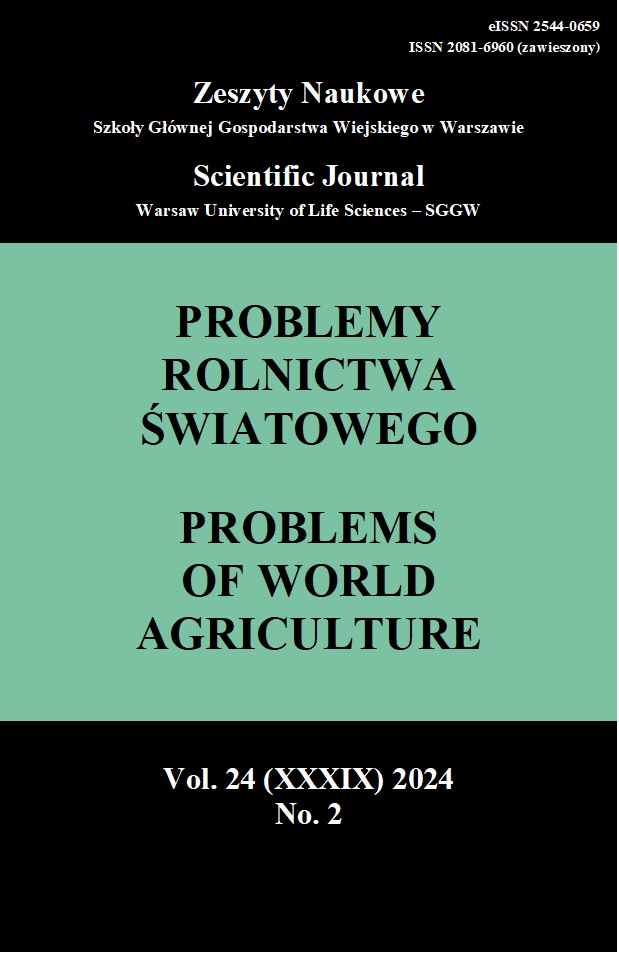Main Article Content
Article Details
Abbadi, Sh., Senadza, B., Lieuw-Kie-Song, M., Abebe, H. (2019). Assessing the Employment Effects of Processing Cocoa in Ghana. Strengthen Publication Series, International Labour Office. Pobrano z: https://www.ilo.org/wcmsp5/groups/public/---ed_emp/---ifp_skills/documents/publication/wcms_ 673136.pdf.
Bank Światowy (2023). Pobrano z: https://data.worldbank.org/country/ghana.
Beg, M.S., Ahmad, S., Jan, K., Bashir, K. (2017). Status, supply chain and processing of cocoa - a review. Trends in Food Science & Technology, 66, 108-116, https://doi.org/10.1016/j.tifs.2017.06.007. (Crossref)
Bermudez, S., Voora, V., Larrea, C., Luna, E. (2022). Global Market Report: Cocoa prices and sustainability. Sustainable Commodities Marketplace Series. Pobrano z: https://www.iisd.org/system/files/2022-11/2022-global-market-report-cocoa.pdf.
Boeckx, P., Bauters, M., Dewettinck, K. (2020). Poverty and climate change challenges for sustainable intensification of cocoa systems. Current Opinion in Environmental Sustainability, 47, 106-111, https://doi.org/10.1016/j.cosust.2020.10.012. (Crossref)
Czarny, E. (2002). Teoria i praktyka handlu wewnątrzgałęziowego. Monografie i Opracowania / Szkoła Główna Handlowa, Numer 496.
Daniels, S., Lauderach, P., Paschall, M. (2012). Fine flavor cocoa in Ghana: reaching high value markets. Pobrano z: https://www.iied.org/16036iied.
Encyklopedia PWN. Ghana. Historia. Pobrano z: https://encyklopedia.pwn.pl/haslo/;4574135
FAOSTAT. Pobrano z: https://www.fao.org/faostat/en/#data/QCL
Goldman, E., Weisse, M.J., Harris, N., Schneider, M. (2020). Estimating The Role of Seven Commodities in Agriculture-Linked Deforestation: Oil Palm, Soy, Cattle, Wood Fiber, Cocoa, Coffee, and Rubber, World Resources Institute. Pobrano z: https://files.wri.org/d8/s3fs-public/estimating-role-seven-commodities-agriculture-linked-deforestation.pdf.
Gomes, L. (1987). Foreign Trade and the National Economy. Mercantilist and Classical Perspectives. MacMillan Press. DOI 10.1007/978-1-349-08992-5. (Crossref)
Gereffi, G., Humphrey, J., Sturgeon, T. (2005). The Governance of Global Value Chains. Review of International Political Economy, 12(1), 78-104. http://www.jstor.org/stable/25124009. (Crossref)
Hummels D., Ishii J., Yi K.-M. (2001). The Nature and Growth of Vertical Specialization in World Trade. Journal of International Economics, 54(1), 75-96, https://doi.org/10.1016/S0022-1996(00)00093-3. (Crossref)
ICCO. Pobrano z: https://www.icco.org/statistics/.
IFASTAT. Pobrano z: https://www.ifastat.org/databases.
IMF (2023). Pobrano z: https://www.imf.org/en/News/Articles/2023/10/05/pr23339-ghana-imf-reaches-sla-1st-rev-ecf-conducts-discussions-2023-art-iv-consult.
Jahurul, M.H.A. Zaidul, I.S.M., Norulaini, N.A.N., Sahena, F., Jinap, S., Azmir, J. Sharif, K.M., Mohd Omar, A.K. (2012). Cocoa butter fats and possibilities of substitution in food products concerning cocoa varieties, alternative sources, extraction methods, composition, and characteristics. Journal of Food Engineering, 117, 467-476. (Crossref)
Klimiuk, Z. (2016). Ewolucja tradycyjnych koncepcji handlu zagranicznego w teorii ekonomii. Zeszyty Naukowe PWSZ w Płocku Nauki Ekonomiczne, 24, 7-25.
Krugman, P. (2010). Rewolucja rosnących przychodów w handlu i geografia. Gospodarka Narodowa, 11-12, 1-17. (Crossref)
Kolavalli, S., Vigneri, M. (2011). Cocoa in Ghana: Shaping the Success of an Economy. [w]: Chuhan-Pole, P., Manka, A., [Red.] Yes, Africa Can: Success Stories from a Dynamic Continent. World Bank. Pobrano z: https://documents1.worldbank.org/curated/ru/304221468001788072/930107812_201408252033945/additional/634310PUB0Yes0061512B09780821387450.pdf.
Komisja Europejska (2022). Wniosek dotyczący Dyrektywy Parlamentu Europejskiego i Rady w sprawie należytej staranności przedsiębiorstw w zakresie zrównoważonego rozwoju oraz zmieniającej dyrektywę (UE) 2019/1937, COM(2022) 71 final 2022/0051(COD). Pobrano z: https://data.consilium.europa.eu/doc/ document/ST-15024-2022-REV-1/PL/pdf.
Komisja Europejska (2021). Proposal for a REGULATION OF THE EUROPEAN PARLIAMENT AND OF THE COUNCIL on the making available on the Union market as well as export from the Union of certain commodities and products associated with deforestation and forest degradation and repealing Regulation (EU) No 995/2010, COM(2021) 706 final 2021/0366 (COD). Pobrano z: https://environment.ec.europa.eu/system/ files/2021-11/COM_2021_706_1_EN_ACT_part1_v6.pdf.
Kongor, J.E., De Steur, H., Van de Walle, D., Gellynck, X., Afoakwa, E.O., Boeckx, P., Dewettinck, K. (2018). Constraints for future cocoa production in Ghana. Agroforestry Systems 92, 1373-1385, https://doi.org/10.1007/s10457-017-0082-9. (Crossref)
Lahive, F., Hadley, P., Daymond, A.J. (2019). The physiological responses of cacao to the environment and the implications for climate change resilience. A review. Agronomy for Sustainable Development, 39, 5, https://doi.org/10.1007/s13593-018-0552-0. (Crossref)
Luderer, B., Nollau, V., Vetters, K. (2010). Mathematical formulas for Economists. Fourth Edition, Springer. (Crossref)
Naadi, Th. (2023). How Ghana's central bank lost $5bn in one year. Pobrano z: https://www.bbc.com/news/business-66947202.
Pawlak, K., Smutka, L. (2022) Does Poland’s agri-food industry gain comparative advantage in trade with non-EU countries? Evidence from the transatlantic market. PLoS ONE 17(9): e0274692. https://doi.org/10.1371/ journal.pone.0274692. (Crossref)
Rada Europejska (2022). 2022/0051(COD), 15024/1/22 REV 1. Pobrano z: https://data.consilium.europa.eu/doc/ document/ST-15024-2022-REV-1/pl/pdf.
Sako, M. (2006). Outsourcing and Offshoring: Implications for Productivity of Business Services. Oxford Review of Economic Policy, 22(4), 499-512. Pobrano z: http://www.jstor.org/stable/23606777. (Crossref)
Suh, N.N., Molua, E.L., (2022). Cocoa production under climate variability and farm management challenges: Some farmers' perspective. Journal of Agriculture and Food Research, 8, 100282, https://doi.org/10.1016/ j.jafr.2022.100282. (Crossref)
Szczepaniak, I. (2019). Changes in comparative advantages of the Polish food sector in world trade. Equilibrium. Quarterly Journal of Economics and Economic Policy,14(3), 463-480, https://doi.org/10.24136/eq.2019.022. (Crossref)
Tothmihaly, A. (2017). How low is the price elasticity in the global cocoa market? Global Food Discussion Papers, No. 102, http://dx.doi.org/10.22004/ag.econ.258587.
Tröster, B., Staritz, C., Grumiller, J., Maile, F. (2019). Commodity dependence, global commodity chains, price volatility and financialisation: Price-setting and stabilisation in the cocoa sectors in Côte d'Ivoire and Ghana, ÖFSE Working Paper, No. 62, https://doi.org/10.3390/risks10060115. (Crossref)
Tsowou1, K., Gayi, S.K., (2019). Trade Reforms and Integration of Cocoa Farmers into World Markets: Evidence from African and non-African Countries. Journal of African Trade, 6(1-2), https://doi.org/10.2991/ jat.k.190916.001. (Crossref)
Tuebner, R. (2023). Ghana Climate Change Report, USDA-FAS GAIN Report Number: GH2023-0008. Pobrano z: https://apps.fas.usda.gov/newgainapi/api/Report/DownloadReportByFileName?fileName=Ghana%20Climate%20Change%20Report%20_Accra_Ghana_GH2023-0008.pdf.
Wickramasuriya, A.M., Dunwell, J.M. (2017). Cacao biotechnology: current status and future prospects. Plant Biotechnology Journal, 16(1):4-17, doi: 10.1111/pbi.128482. (Crossref)
van Vliet, J.A., Slingerland, M.A., Waarts, Y.R., Giller, K.E. (2021). A Living Income for Cocoa Producers in Côte d'Ivoire and Ghana? Frontiers in Sustainable Food Systems, 5:732831, doi: 10.3389/fsufs.2021.732831. (Crossref)
Downloads

Utwór dostępny jest na licencji Creative Commons Uznanie autorstwa – Użycie niekomercyjne 4.0 Międzynarodowe.





